





That lovely African violet just jumped into your shopping cart. Now you are worried that you'll kill it, because "everybody knows" they are fussy, delicate plants. Wrong! With a few simple tips, you'll keep your new African violet happy and blooming for years to come.
A little benign neglect can work wonders! Too much TLC in the form of frequent watering is the most common cause of violet death. Like many plants, an African violet (AV) appreciates water but just hates “wet feet.” If your new AV gets too dry, it will wilt and look droopy. If your new AV is too wet, root rot will also make it wilt and look droopy! So you’ll run for your watering can when more water is the last thing it needs. Before you water, stick your finger down into the soil to check for moisture. Water about once a week. Use African violet fertilizer when you water, but use only 1/4 as much as directed. Fertilizing increases growth and blooms, but overfeeding causes problems.
Nobody likes to think that their pretty new plant might have unwanted hitchhikers. But pests happen, and the key to healthy houseplants is isolation. If possible, keep your new African violet away from others for several months, so you can see and treat problems before they spread. Consider a preventative bath with insecticidal soap (be sure to dry the leaves carefully afterward, especially the crown) or a good spray with Neem oil. Establish good isolation practices right at the start, even if you have only one African violet. These tough, beautiful plants can be addictive, so you may have a collection to protect before you know it!
The mix that growers use works well in greenhouse conditions but generally holds far too much water to keep your new African violet happy at home. The best thing you can do for your new plant is to repot it right away into a lighter mix. Adding one part horticultural perlite to one part good quality soil-less potting mix gives you a mix that holds some moisture but still drains freely.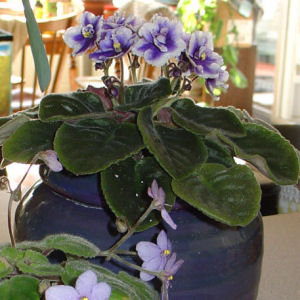 Two-piece “self watering” planters work beautifully for many African violets. Because these planters tend to keep the mix on the wet side of moist, using a light potting mix is even more important. I use a ratio of 2 parts perlite to one part potting mix in self watering pots. “Less is more” when adding water to this type of pot. If the bottom half inch or less of the inner pot is wet, the reservoir (outer pot) has enough water. Letting the reservoir go dry for several days every month or two helps keep the roots healthy. If the mix in the inner pot really dries out, add a little water from the top to restart the self-watering action. Rarely, a particular plant will just sulk in one of these pots, but most standard AVs I've grown really love them.
Two-piece “self watering” planters work beautifully for many African violets. Because these planters tend to keep the mix on the wet side of moist, using a light potting mix is even more important. I use a ratio of 2 parts perlite to one part potting mix in self watering pots. “Less is more” when adding water to this type of pot. If the bottom half inch or less of the inner pot is wet, the reservoir (outer pot) has enough water. Letting the reservoir go dry for several days every month or two helps keep the roots healthy. If the mix in the inner pot really dries out, add a little water from the top to restart the self-watering action. Rarely, a particular plant will just sulk in one of these pots, but most standard AVs I've grown really love them.
Don’t rush to repot your new plant into a larger pot. If the roots only partly fill the pot, a smaller pot may be better. Having a lot of extra potting mix around the root ball just makes “wet feet” more likely. Most standard size plants will never need anything larger than a 4 inch pot. The rule of thumb says the diameter of the plant should be two to three times the diameter of the pot.
Give the pot a firm tap to loosen the roots, and then upend the plant into your hand. Fiddle with the roots to remove as much of the old, heavy mix as you can. If you are reusing a pot, give it a hot wash or bleach dip. Moisten the potting mix with just enough water that the mix can be squeezed into a ball that falls apart as you open your hand. Fill in the new mix gently around the roots of the plant. Your goal is to firm the plant into place, not to pack in as much mix as possible. I prefer not to “water in” a repotted AV, because over-watering happens easily. Since your mix is moist, the plant has enough water for the week.
Now you need to find a good spot to grow and enjoy your new plant. African violets like the same temperature and humidity conditions that we prefer, so that part is usually easy. You often see AVs on windowsills, but that location might be too cold and drafty in winter. If your house is really dry, raise the humidity around your plant by putting its pot on a saucer with water and gravel. The gravel raises the pot so the plant sits above the water, not in it.
Your African violet will grow and bloom best in bright indirect light. “Indirect” means it would rather grow next to a south or west facing window rather than directly in the square of sunshine coming through the window. East windows are often perfect for AVs. If your plant isn’t getting enough light, the leaves will grow upwards as if reaching for the sun. Too much light makes the leaves grow downwards or get tight in the center.
All these tips might make you think African violets are as picky as Goldilocks. Actually, an AV is much easier to please. Move it once or twice, and you'll find its favorite spot. Use a light soil mix and a light hand with water and fertilizer. Your new plant will find its new home "just right," and you'll be rewarded with weeks and years of beautiful blooms!
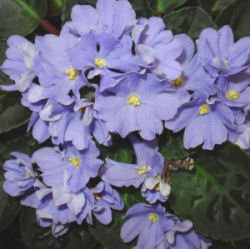
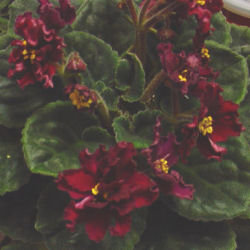
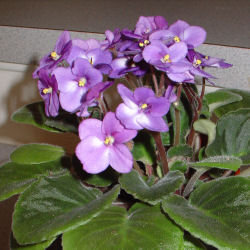
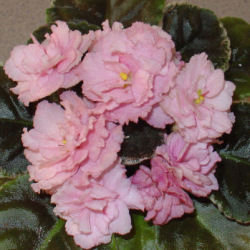
For more information, check out the FAQ and the extensive list of links in the “sticky” thread at the top of the African Violets and Gesneriads Forum (subscribers only). The “culture pages” at Rob’s Violet Barn are one of my favorite references, especially this guide to repotting a violet, with step by step photos. More information and photos are constantly being added to the African violet entries in PlantFiles. AVSA (the African Violet Society of America) is an unbeatable resource -- there’s probably an African violet club near you!
Copyright © www.100flowers.win Botanic Garden All Rights Reserved